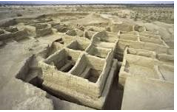i INP-WEALTHPK
Faiza Tehseen
Efforts are direly needed to make Mehrgarh remains a major tourist destination.

“Mehrgarh remnants, situated in Balochistan, are relatively unknown to both national and international tourists. This ancient asset is in dire need of consistent conservation efforts,” Dawood Tareen, Director Culture and Focal Person of Tourism Department, Balochistan, said. Talking to WealthPK, he said awareness among the locals and other stakeholders was important to make Mehrgarh a popular tourist spot.
He said that putting in place proper infrastructure, establishing tourist facilitation centres, ensuring seamless communication means, security and other amenities were important for promoting a tourist destination. “The promotion of Mehrgarh at both national and international levels will not only improve the number of visitors, the region would also be developed.” Tareen said it was high time the policymakers considered the value of archaeological sites.
“The conservation of these assets will not only keep them preserved but will also ensure prosperity for the local communities.” Talking to WealthPK about the historical background and importance of Mehrgarh, Dr Mehmoodul Hasan Shah, former deputy director of the Department of Archaeology and Museums, Islamabad, said, “Dating back to 8,000 BCE, and situated at the foot of Bolan Pass, Mehrgarh is one of the globally known earliest settlement sites, having witnessed the Neolithic period (new stone age) and chalcolithic period (parallel use of stone and metal tools).”
He said that varied geographic characteristics of Bolan Pass, one of the main ancient routes connecting the Central Asian high inland plateau to the alluvial Indus River plains, stimulated the early agrarians to give up cave dwellings, hunting and gathering around the eighth millennium BC. Shah said: “Mehrgarh is one of the most important Neolithic sites in South Asia. On the basis of the evidence, it is proved that the people of Mehrgarh were the precursor of Indus Valley civilisation.
This civilisation reflects the development of agricultural technologies, and agrarian lifestyle of ancient South Asian stone age people.” He said that architecture in Mehrgarh was freestanding, multi-roomed, square or rectangular small houses, constructed with dried clay lumps or sun-dried mud bricks. “The settlement had several burial sites. As a fertility cult, small clay human figurines were kept in the houses, besides handmade, coarsely textured pottery in 5,000 BC.
While fine wheel-turned pottery characterised by red and black painted designs depicting geometric patterns, animals, and human figures was started in 4,500 BC.” Shah said, “Most of the artefacts and jewellery were crafted from lapis lazuli and copper. One of the ornaments is still carrying the trace of a cotton thread, the oldest known example of this fibre being used.
Early agricultural practices and animal domestication are evidenced in the remains of Mehrgarh. The people of Mehrgarh abandoned the site in 2,700 BC and settled down at Nausharo, some six kilometres south of Mehrgarh.”
Credit: INP-WealthPk



